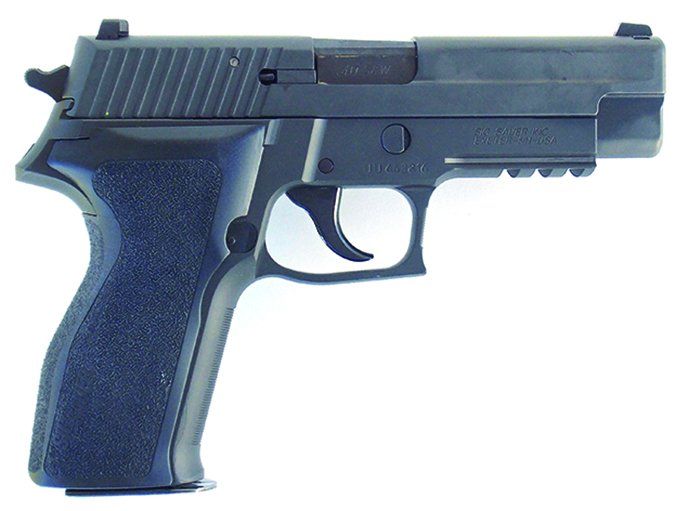
Pistols chambered for the 40 S&W round often are the odd man out as the first choice of a citizen contemplating arming himself or herself. Most of us choose the 45 ACP for its terminal performance and the 9mm Luger for capacity. Here, though, this report is in part a continuation of 40-caliber ammunition tests we conducted some years ago. One of our raters has much field experience and favored the 45 ACP and did not give the 40 S&W much attention. After empirical testing, he came to the conclusion that the 40 is more like the 45 than the 9mm in terminal ballistics, and that’s a good place to be. This rater also tested compact and subcompact 40-caliber pistols and came away believing that forties lighter and smaller than the Glock 23 are too much for most shooters to handle well. So, it was logical that he gravitated toward service-size 40 S&W handguns as the right fit of cartridge and pistol.
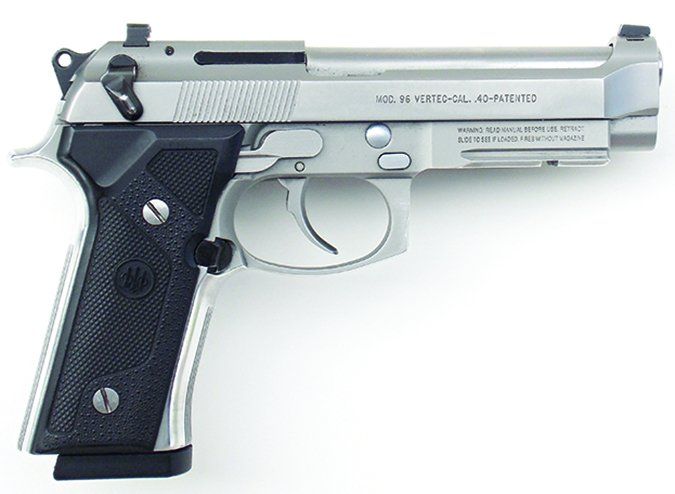
Full-size handguns are among the most common 40 S&W handguns chosen for home and personal defense. They are relatively mild to fire and reliable.
With these facts in mind, we wanted to test four 40-caliber handguns of different configurations to see which one suited our testers the best. Also, we went looking for value, shooting two brand-new guns against veterans which, perhaps, still had some game left in them. The two new guns were a selective-double-action CZ 75B and the double-action-only Ruger SP40, which we found listing around $580 and $569, respectively. The other choices were the double-action first-shot SIG P226R and the double-action first-shot Beretta 96 Vertec Inox, the latter a used model and the former was a factory rebuild offered by SIG Sauer.
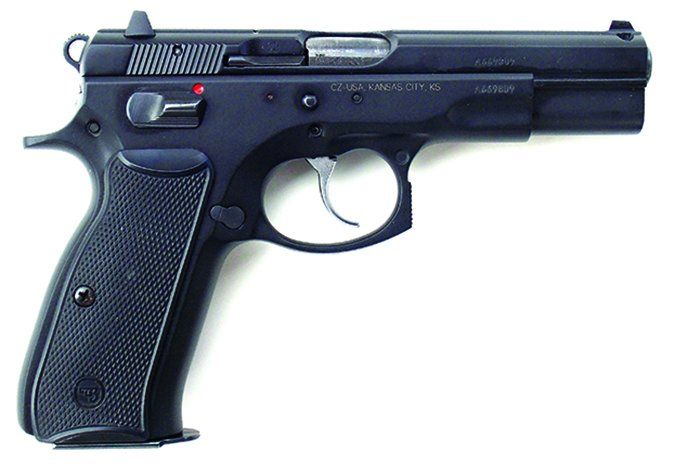
The Beretta Model 96 Vertec has received praise from us before, being named a Gun of the Year in 2005 after being evaluated in the April 2005 issue. We said then, “Alloy 40 S&W pistols have a well-earned reputation for packing plenty of power in their lightweight frames, but they are also well-known for being vicious kickers for the training shooter. However, the Model 96 Vertec was an exception.” In particular, we liked the vertical grip design that, combined with the thinner grip panels and short-reach trigger, made the pistol much friendlier to shooters with smaller hands. We liked it because its flat-sided feel and more rectangular shape were easier to index, that is, get in proper alignment faster. This time we tested the stainless version.
Certified Pre-Owned SIG Sauer pistols like the P226R tested here are often traded in by law-enforcement agencies for new SIGs, and the company puts the pre-owned SIG pistols through a stringent Factory Certification process. Each pistol is stripped, refitted with original factory parts where needed, cleaned, lubricated, function tested and hand-inspected by a factory technician. Each Factory Certified pre-owned SIG comes with a one-year warranty and one standard-capacity magazine. The condition of these pistols will vary depending on the amount of wear, such as that caused by a holster and ring wear, and that condition will be reflected in the retail price. Dings and holster wear and ring scratches are not covered under the one-year factory warranty.
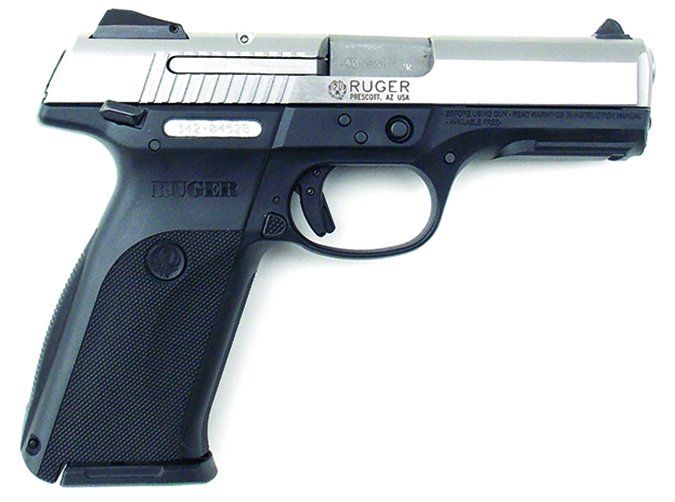
We tested a similarly set up CZ 75B previously (May 2009), but chambered in 9mm. In that test we noted the accuracy of the CZ was about 2.5 inches for all shots fired at 15 yards. We also noted the heavy CZ dampened 9mm recoil, and there were no problems with the CZ whatsoever. It appeared to be very well made and built to last. We looked forward to testing the 40 S&W version.
Likewise, we tested a Ruger SR40 previously, most recently in the October 2011 issue. In that review, we said, the SR40 was remarkably underrated, and it might be a plastic gun for people who don’t like plastic guns. We said, “Its slender profile makes it more controllable than most high-capacity guns, and it’s a good candidate for concealed carry, too. We liked having manual safeties even if they weren’t perfect. Though not match grade, we thought the trigger was predictable with a reasonable sense of take-up and overtravel.” That model was the BSR40, with an all-black color scheme and a 15+1 capacity, which is now listed by the company as Model 3471. This new SR40 is Model 3470, still with the same 15+1 capacity, but this time with a brushed-stainless-steel slide.
It is good to note up high that even with the mix of operating systems and handling characteristics, we encountered no failures to feed, chamber, fire, or eject with any loads in any of the handguns tested. Of course, there were things we didn’t like or liked more on one gun than another, and for those insights, continue reading below:
CZ-USA CZ 75B 01120 40 S&W, $580
GUN TESTS GRADE: B-
The CZ 75 was accurate, reliable, and combat worthy. The shortcomings were due to lack of two practical features: No decocker and no accessory rail.
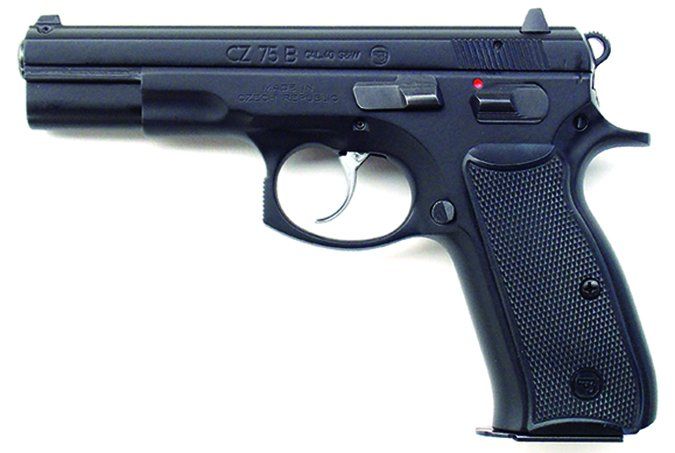
| ACTION | Double action semi-auto, locked breech |
| OVERALL LENGTH | 8.1 in. |
| OVERALL HEIGHT | 5.4 in. |
| MAX WIDTH | 1.4 in. |
| WEIGHT UNLOADED | 35.02 oz. |
| WEIGHT LOADED | 43.5 oz. |
| BARREL LENGTH | 4.6 in. |
| BARREL | Blued steel |
| MAGAZINE | (1) 10-rd. blued steel |
| SLIDE | Black polycoated steel |
| FRAME | Black polycoated steel |
| FRAME FRONT STRAP HEIGHT | 2.75 in. |
| FRAME BACK STRAP HEIGHT | 3.75 in. |
| GRIP | Plastic |
| GRIP THICKNESS | 1.4 in. |
| GRIP CIRCUMFERENCE | 5.4 in. |
| SIGHTS | Black polycoated steel |
| TRIGGER PULL WEIGHT DOUBLE ACTION | 14 lbs. |
| TRIGGER PULL WEIGHT SINGLE ACTION | 4.5 lbs. |
| TRIGGER SPAN SINGLE ACTION | 2.6 in. |
| SAFETY | Manual lever, firing pin block |
| WARRANTY | 5-year limited |
| PHONE | (800) 955-4486 |
| WEBSITE | CZ-USA.com |
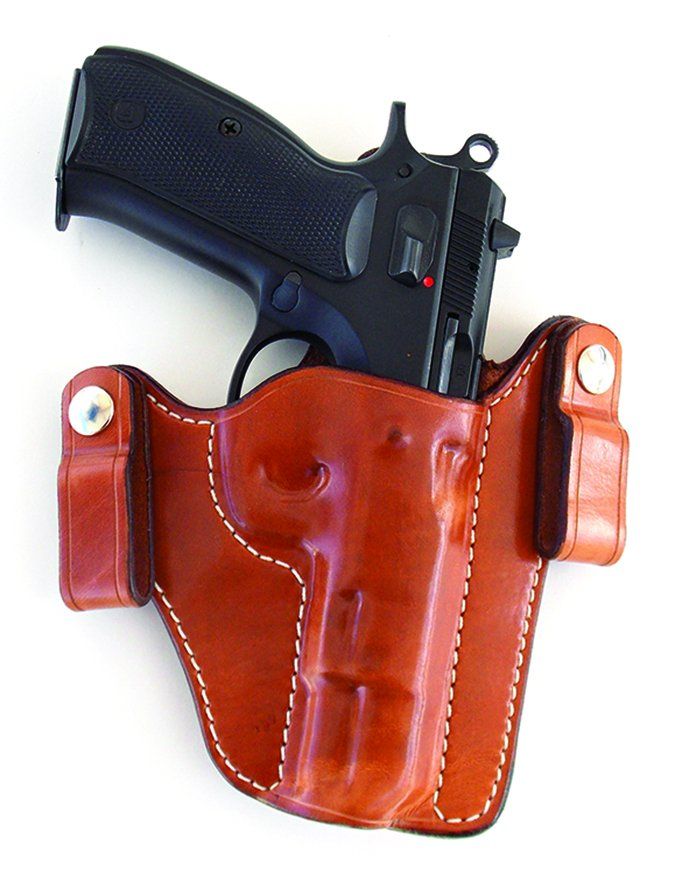
The ‘B’ designation indicates that the model is equipped with a firing-pin-block safety. The price is a recent cost at Cheaper Than Dirt. The manufacturer number of 01120 reflects a gun that ships with a 10-round magazine, but we tested with Mec-Gar 12-round magazines that are widely available, including at Midsouth Shooter’s Supply for $26.
The CZ-USA 75B looked at first glance to be a replica of the thousands of CZ 75 pistols sold worldwide. The CZ 75B was finished in a black coating that is evenly applied and attractive. The pistol’s dust cover is thicker than on the 9mm, so some holsters, such as the tightly fitted Lobo Gunleather IWB used in the test, will require a significant break-in period before the handgun will properly fit a holster blocked for the 9mm CZ 75 B. The sights were an improvement over the original CZ design, combat sights that offered rapid acquisition and a clear sight picture. They were enameled with a green three-dot treatment. The paint was self luminous and glowed green for some time after being exposed to light.
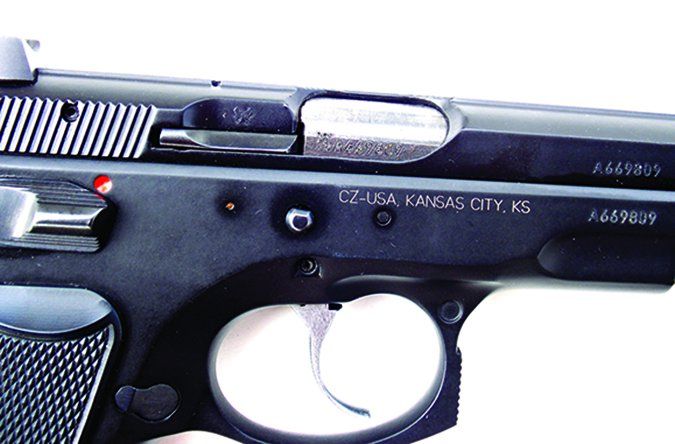
The cocking serrations were adequate; however, some effort was required to cock the slide. That’s because the slide rides lower in the receiver than on the other handguns. The CZ uses a system in which the slide rails are inside the frame, the opposite of most handguns. The result is a good slide-to-frame interface and also a lower bore axis than most other double-action handguns.
The double-action trigger was long, but smooth, at 14 pounds. The single-action trigger press was clean at 4.5 pounds with the slight backlash characteristic of the type. The grip was comfortable, with a modest S curve that made for a good fit and feel.
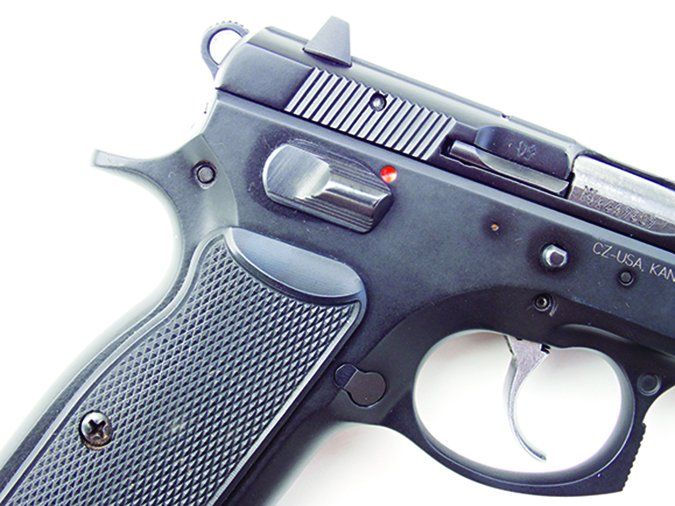
The pistol was a double-action first-shot handgun. The manual safety was well placed for ergonomic manipulation. The safety cannot be placed in the Fire position with the hammer down. (Clones may differ.) The CZ 75B is often termed a selective-double-action pistol. This is because the hammer may be cocked and the safety applied, allowing cocked-and-locked carry. While some find this carry well suited to their personal scenarios, the raters believed this was not the original intent. We believe that the pistol was designed to be carried hammer down. Then, after the first shot, you are better prepared to be in a gunfight. The conventional double-action first-shot pistol would have to be decocked for safe movement during tactical maneuvers. The CZ may be quickly placed on Safe after the first shot is fired, then the shooter can simply thumb the safety off and resume firing. This is a tactical advantage.
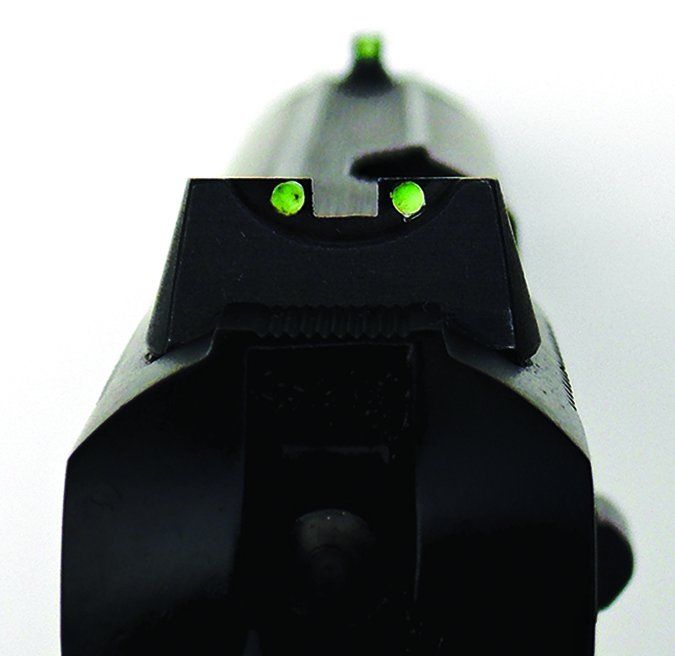
The practical advantage of the SIG and Beretta double-action pistols is that the hammer may be decocked without ever touching the trigger. To make the CZ ready, the slide is lowered on a loaded magazine and the thumb controls the hammer as the trigger is pressed to lower the hammer. A shooter adopting the CZ 75 must be aware of this system at all times.
The pistols were fired with SIG Sauer 180-grain FMJ loads ($20/50 @ Brownells.com) during the combat firing stage. Drawing from concealment and firing at man-sized targets at 7 yards, we expended two magazines and then moved to firing groups as rapidly as possible at 10 yards. We loaded magazines with 10 rounds for these drills, with the last drill firing 10 shots offhand at 15 yards. The CZ 75 was fired in the double-action first-shot mode. The pistol gave a good accounting of itself, with good control and combat accuracy. The raters felt that this pistol showed the best combat type shooting results.
Next, the pistol was fired for accuracy from a solid benchrest firing position at 25 yards. Ammunition included the Black Hills Ammunition 180-grain JHP, the Hornady 155-grain XTP, and the Winchester Win3Gun 180-grain FMJ loading. Accuracy was consistent, with most groups averaging less than 2.5 inches, a good showing. The best average came with the Hornady 155-grain XTP at 1.9 inches. The CZ was more accurate than the Ruger and edged the Beretta out by a small margin. The SIG was more accurate with every load, but only by a small margin.
Our Team Said: Raters were split on the CZ 75 B. All gave the pistol high marks for reliability. Accuracy was excellent. The pistol is comfortable to fire. The lack of a decocking lever was a serious drawback to some. This was the personal pistol of our most experienced rater, and he feels that the CZ 75B isn’t the pistol for the casually interested shooter. We feel that for most users, the SIG system is superior. Another demerit came for the lack of a light rail.
Beretta 96 Vertec Inox 40 S&W, $600 (Used)
GUN TESTS GRADE: A
Accuracy was good, if not outstanding. The pistol was reliable and we liked the safety features. The Beretta offers the lowest magazine capacity of the pistols tested. Beretta fans will likely prefer the Inox over the others, but we preferred the SIG P226.
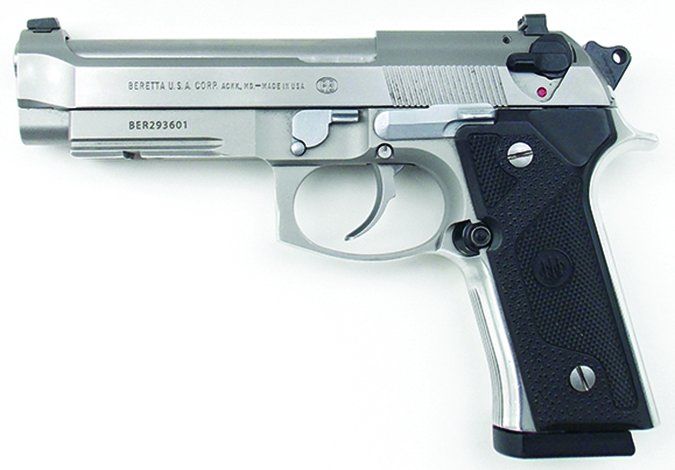
| ACTION | Double-acton semi-auto, locked breech |
| OVERALL LENGTH | 8.5 in. |
| OVERALL HEIGHT | 5.4 in. |
| MAX WIDTH | 1.5 in. |
| WEIGHT UNLOADED | 32 oz. |
| WEIGHT LOADED 11 RDs | 39.7 oz. |
| BARREL LENGTH | 4.9 in. |
| BARREL | Stainless steel |
| MAGAZINE | Steel, 11 rounds |
| SLIDE | Stainless steel, open design |
| FRAME | Aluminum, 1-slot accessory rail |
| FRAME FRONT STRAP HEIGHT | 2.4 in. |
| FRAME BACK STRAP HEIGHT | 3.5 in. |
| GRIPS | Plastic |
| GRIP THICKNESS | 1.3 in. |
| GRIP CIRCUMFERENCE | 5.5 in. |
| SIGHTS | Steel |
| TRIGGER PULL WEIGHT DOUBLE ACTION | 15 lbs. |
| TRIGGER PULL WEIGHT SINGLE ACTION | 4 lbs. |
| TRIGGER SPAN SINGLE ACTION | 2.4 in. |
| SAFETY | Manual safety/Decocker |
| WARRANTY | N/A |
| TELEPHONE | (800) 237-3882 |
| WEBSITE | BerettaUSA.com |
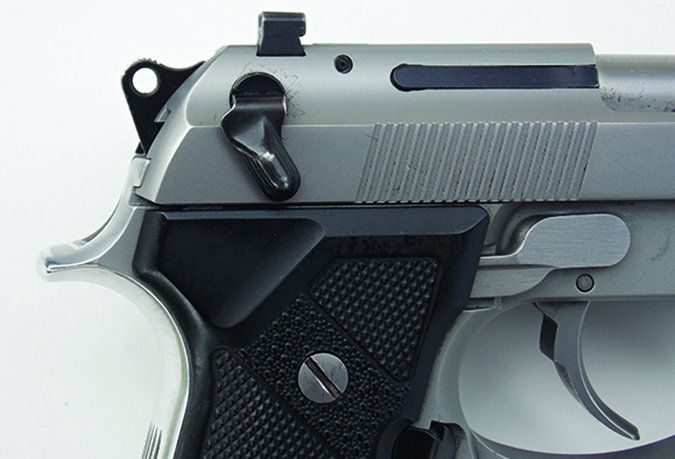
Introduced in 1990, the Beretta 96 is a 40 S&W chambering of the Beretta 92 9mm pistol. It was discontinued in 2007. The Vertec variation is similar to the new Beretta 96A1. The Vertec has several parts made of stainless steel, also known as inox steel, or inox, from the French “inoxydable”: the slide (extractor, safety, and manual safety lever), the barrel, the trigger and trigger pin, the slide-stop lever, and the grip screws.
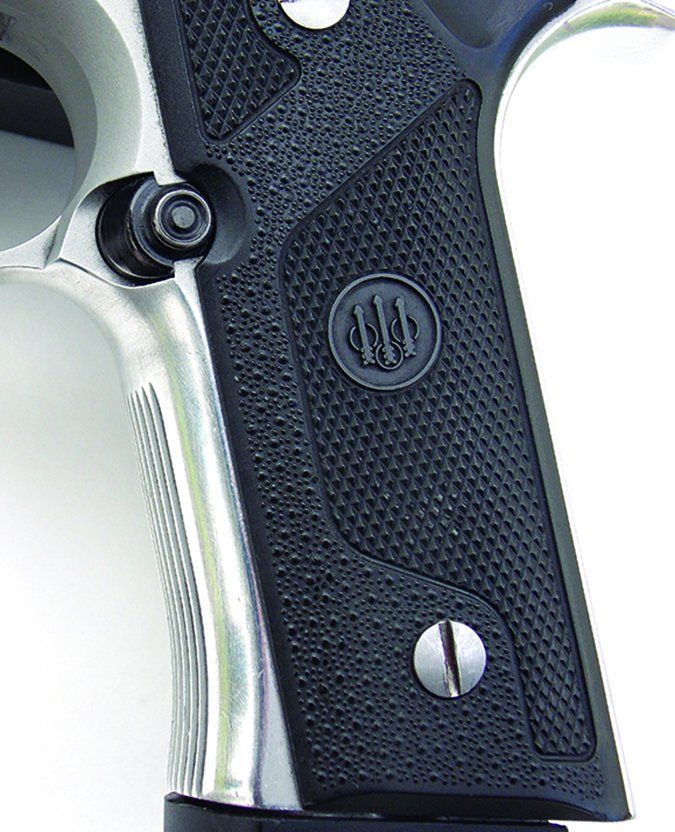
The anodized aluminum grip frame is intended to fit most hands well and alleviate concerns over the large grip of the high-capacity Beretta handgun. While more comfortable than the original Beretta grip, the Vertec treatment doesn’t seem to lower the pistol’s bore axis in the hand, we found. The stainless slide offers nice polish; even though this was a used gun (perhaps a police trade-in), our shooters thought it was more attractive than the new Ruger. There was no eccentric wear noted on the locking wedge, which appeared original, but there were signs the pistol had seen use. The decocker and magazine release were well worn.

The sights are good examples of combat sights. The front sight was dovetailed in place, an advantage over the Beretta 92. The pistol featured night sights, and they still had some self-luminous glow — we’d guess about 60 percent of full, new tritium brightness.
The pistol is a double-action first-shot pistol. In common with the CZ and SIG tested, the first shot cocks and drops the hammer. After the first shot, the slide cocks the hammer for subsequent shots. The trigger action was smooth, if long, at about 15 pounds. The single-action trigger mechanism broke at 4 pounds — the lightest single-action trigger tested.
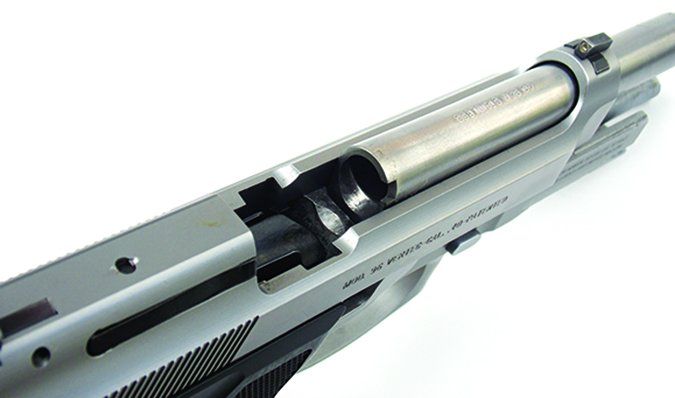
The decocker was slide mounted and also acts as a manual safety. If carried on Safe, the action to take the safety off isn’t nearly as ergonomic as a frame-mounted safety. However, with a rapid straight-thumb motion, it may be operated with a degree of rapidity. We like the SIG’s frame-mounted decocker better, but then there isn’t a need for a speed decock. If you prefer your double-action pistol to have a safety, then the Beretta should be your choice. The Beretta magazine holds 11 rounds, one fewer than the other double-action pistols and four fewer than the Ruger.
Our Team Said: All in all, we thought this used gun was well worth the money. The pistol was reliable and performed well during the firing tests. The Vertec grip gave a good fit and allowed real speed on the draw. The pistol wasn’t as ergonomic as the CZ; however, despite a higher bore axis in the hand, the Beretta was comfortable to fire and use. Accuracy on the combat course was rated below the CZ and the SIG. In benchrest accuracy, the single most accurate loading was the Black Hills 180-grain jacketed hollowpoints, with an average of 2.3 inches.
Factory Certified Pre-Owned SIG P226R 40 S&W, $725
GUN TESTS GRADE: A+
The pre-owned SIG P226R turned in as-new performance. Reliable and fast handling, the SIG got high marks during the firing tests. The pistol was ergonomic and fit most hands well. The double-action trigger was very smooth. The pistol’s advantage over the other handguns was its accuracy.
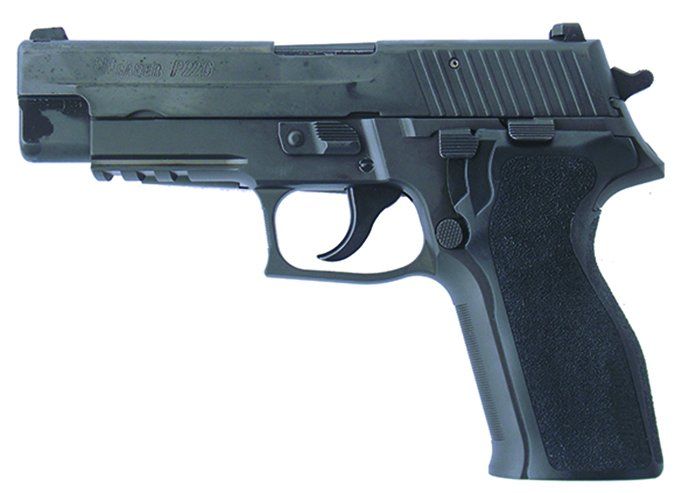
| ACTION | Double-action semi-auto, locked breech |
| OVERALL LENGTH | 7.7 in. |
| OVERALL HEIGHT | 5.5 in. |
| MAX WIDTH | 1.5 in. |
| WEIGHT UNLOADED | 34 oz. |
| WEIGHT LOADED 12 RDs | 42.4 oz. |
| BARREL LENGTH | 4.4 in. |
| BARREL | Blued steel |
| MAGAZINE | 12 rounds, blued steel |
| SLIDE | Steel |
| FRAME | Aluminum |
| FRAME FRONT STRAP HEIGHT | 2.5 in. |
| FRAME BACK STRAP HEIGHT | 3.4 in. |
| GRIPS | Plastic |
| GRIP THICKNESS | 1.4 in. |
| GRIP CIRCUMFERENCE | 5.6 in. |
| SIGHTS | Steel |
| TRIGGER PULL WEIGHT DOUBLE ACTION | 12 lbs. |
| TRIGGER PULL WEIGHT SINGLE ACTION | 4.25 lbs. |
| TRIGGER SPAN SINGLE ACTION | 2.4 in. |
| SAFETY | No manual safety |
| WARRANTY | 1 year |
| TELEPHONE | (603) 610-3000 |
| WEBSITE | SIGSauer.com |
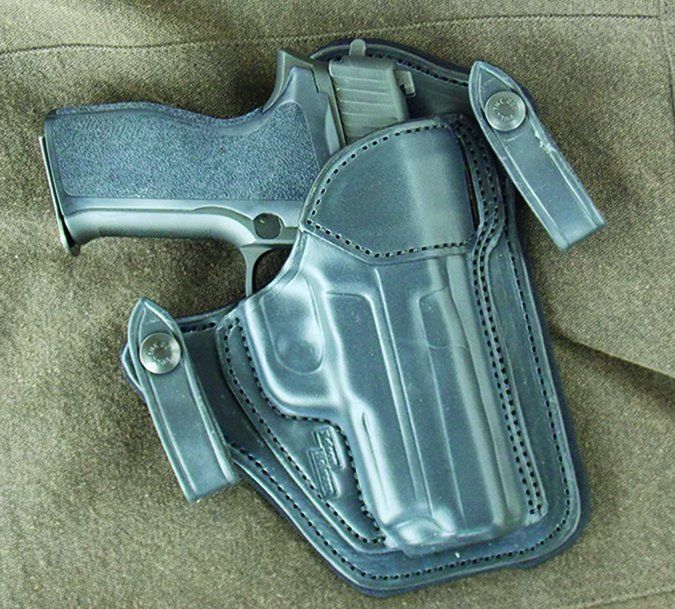
This was our price from South Carolina Gun Company. This was a police service pistol that has been refurbished. The pistol was delivered in a red cardboard box to distinguish it as a factory refurbished item. Still, the pistol appeared as new. The fit, finish, and quality control on the SIG left little more to be desired. Savings were $225 compared to the common $950 counter price of a new P226 with a rail and regular sights. Like two other test pistols, this one featured a rail, thus the “R” designation in the model number (which has been dropped from currently manufactured guns, most of which include a rail).
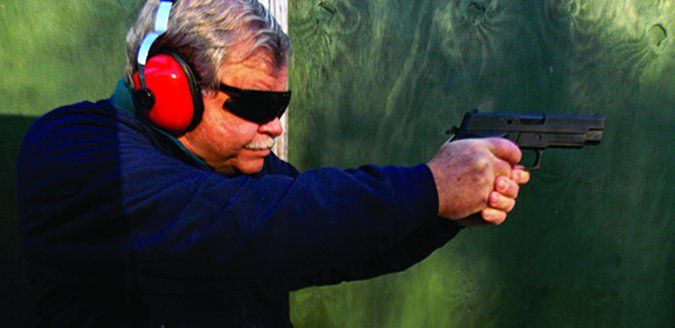
The SIG is a double-action first-shot pistol like the Beretta, but it featured no manual safety. The decocker was very ergonomic, located between the trigger guard and the grip frame. The trigger action was the smoothest double-action first-shot pistol tested, with a break at about 12 pounds. The single-action trigger broke at 4.25 pounds. Reset was much faster than other SIGS we have tested.
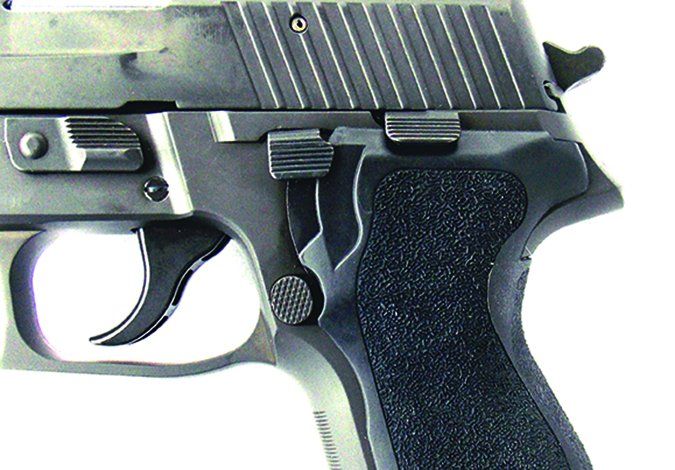
The sights were good examples of combat sights, with the typical SIG white outline treatment. The grip frame fit most hands well. The bore axis sat higher in the hand than the CZ or Ruger, and similar to the Beretta 96, and recoil moved straight back down the shooter’s arm. Handfit was comparable to the Beretta, but not quite on the par with the CZ for most shooters.
The pistol was fast on target, and the smooth trigger action aided in landing a fast and accurate first shot. Control in rapid fire was comparable to the Beretta and better than the Ruger overall, but the heavier CZ was more controllable and did a better job in rapid fire. Still, in firing double taps and in rapidly engaging targets, the SIG did well. The vote was close.
In the benchrest firing session, it had a clear-cut edge over the other handguns. The refurbished SIG was most accurate with the three loads tested, averaging less than 2 inches for five shots in most of the testing. The Black Hills Ammunition 180-grain JHP exhibited a brilliant 1.4-inch group on one occasion, while the average was 1.9 inches.
Our Team Said: Based on accuracy, reliability, relatively light weight, firing comfort, and a fair price, the Factory Certified Pre-Owned SIG P226R earned an A+ rating.
Ruger SR40 Model 3470 40 S&W, $569
GUN TESTS GRADE: B
The pistol exhibited more felt recoil than the others; however, it was also lighter than the other handguns, so this wasn’t unexpected. The grip fit most hands well. The big advantage of the Ruger is magazine capacity. The pistol holds 15 rounds of hard-hitting 40 S&W ammunition. The pistol’s combat accuracy was acceptable, but in this test, it was the least accurate handgun. We’re not fans of the takedown process.
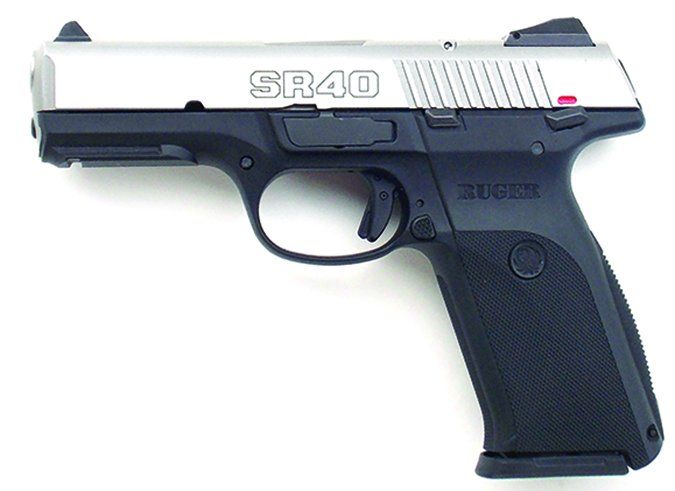
| ACTION | DAO semi-auto, locked breech |
| OVERALL LENGTH | 7.5 in. |
| OVERALL HEIGHT | 5.5 in. |
| MAX WIDTH | 1.3 in. |
| WEIGHT UNLOADED | 26 oz. |
| WEIGHT LOADED | 36.5 oz. |
| BARREL LENGTH | 4.1 in. |
| BARREL | Steel |
| MAGAZINE | 15 rounds, steel |
| SLIDE | Stainless steel |
| FRAME | Reinforced nylon |
| FRAME FRONT STRAP HEIGHT | 2.7 in. |
| FRAME BACK STRAP HEIGHT | 3.75 in. |
| GRIPS | N/A |
| GRIP THICKNESS | 1.25 in. |
| GRIP CIRCUMFERENCE | 5.5 in. |
| SIGHTS | Steel |
| TRIGGER PULL WEIGHT DOUBLE ACTION | 6.5 lbs. |
| TRIGGER SPAN DOUBLE ACTION | 2.5 in. |
| SAFETY | Lever |
| WARRANTY | NA |
| TELEPHONE | (336) 949-5200 |
| WEBSITE | Ruger.com |
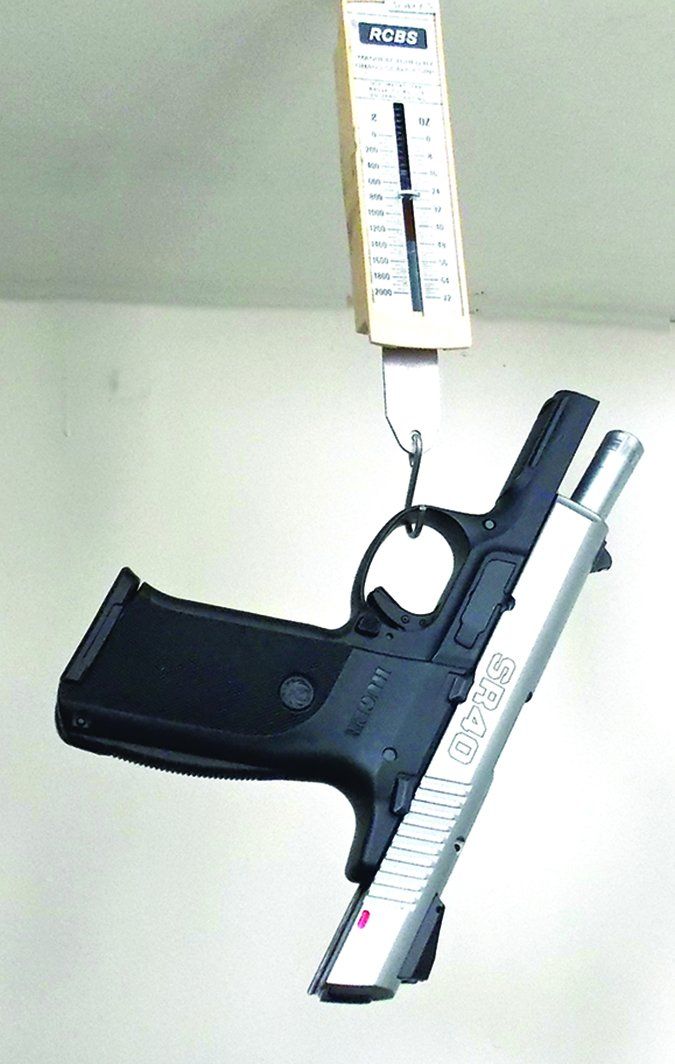
The Ruger featured a polymer frame and stainless-steel slide. This is the lightest pistol tested. Magazine capacity was the highest at 15 cartridges. It was a little stiff loading the last cartridge, but if you choose to load only 14, you still have more cartridges than in the other handguns. The fit and finish were good, and the fit to the frame was acceptable, but there was considerable lateral motion when the slide was grasped and rocked from side to side. The pistol incorporated a light rail, a feature in common with the SIG and the Beretta.
The sights presented a three-dot outline and were acceptable; the notch in the rear sight was smaller than the other pistols, but still usable. The rear sight is actually an insert in a larger sight body and offers good adjustment. We liked the sights of the CZ much better, and the SIG and Beretta sights a little better, than the Ruger.
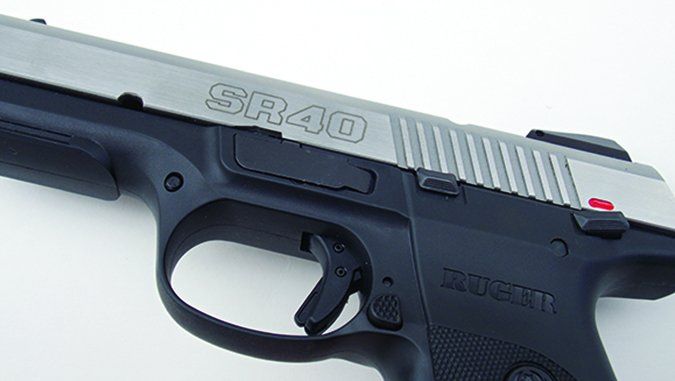
The Ruger is a much fresher, newer design than the 1970’s 9mm designs that have been converted to 40 S&W. The combination of checkering on the side panels and front strap and back strap provided good grip surfaces when firing.
The pistol features a manual safety that may be used or ignored. The Ruger handled well. Felt recoil was the greatest of the handguns tested, a result of light weight and a thin grip cross-section. On the other hand, the grip fit most hands well.
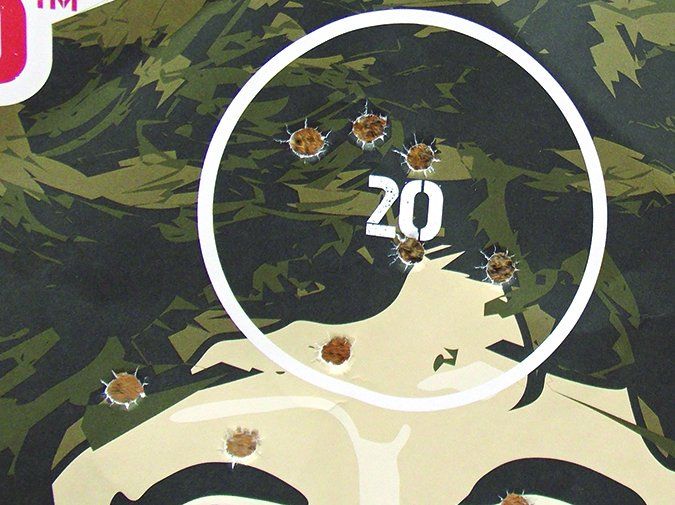
The trigger action was similar to a Glock, with the striker prepped as the slide recoiled. The trigger featured a safety lever set into the trigger face. The trigger broke at 6.5 pounds, the same for every shot, an advantage, some feel, in personal defense. The trigger was good for making first-shot hits. However, the trigger was heavier than the single-action trigger press of any of the other pistols.
Takedown was too complicated, in our view. The slide was locked to the rear, the ejector pressed down, and then the takedown lever pressed out. A tool was needed to press the takedown lever out. As far as takedown, we liked the SIG and Beretta equally, the CZ next, and finally the Ruger.
Our Team Said: The pistol was useful for personal defense and the groups were not bad. However, the SR40 held no advantage over other pistols. Most of the raters felt the other handguns performed better in fast-shooting drills. In benchrest accuracy, the pistol gave credible results, but not up to the standard of the other handguns. The worst groups were almost 3 inches, while the best group, with the Hornady 155-grain XTPs, was just over 2 inches.
Range Data
| Black Hills 40 S&W 180-gr. JHP | Beretta 96 Inox (used) | CZ-USA 75B | Ruger SR40 | SIG Sauer P226R (FCPO*) |
| Average velocity | 984 fps | 998 fps | 975 fps | 966 fps |
| Muzzle energy | 386 ft.-lbs. | 398 ft.-lbs. | 379 ft.-lbs. | 372 ft.-lbs. |
| Smallest group | 2 in. | 1.8 in. | 2.1 in. | 1.4 in. |
| Largest group | 2.5 in. | 2.4 in. | 2.6 in. | 2.4 in. |
| Average group size | 2.3 in. | 2.1 in. | 2.4 in. | 1.9 in. |
| Hornady Custom 40 S&W 155-gr. XTP JHP #9132 | ||||
| Average velocity | 1090 fps | 1124 fps | 1060 fps | 1082 fps |
| Muzzle energy | 408 ft.-lbs. | 434 ft.-lbs. | 386 ft.-lbs. | 402 ft.-lbs. |
| Smallest group | 2.4 in. | 1.5 lbs. | 2.2 in. | 1.6 in. |
| Largest group | 2.8 in. | 2.3 in. | 3 in. | 2.1 in. |
| Average group size | 2.6 in. | 2 in. | 2.6 in. | 1.9 in. |
| Winchester Win3Gun 40 S&W 180-gr. FMJ | ||||
| Average velocity | 990 fps | 970 fps | 944 fps | 969 fps |
| Muzzle energy | 391 ft.-lbs. | 375 ft.-lbs. | 356 ft.-lbs. | 375 ft.-lbs. |
| Smallest group | 2.2 in. | 2 in. | 2.5 in. | 1.8 in. |
| Largest group | 2.8 in. | 2.5 in. | 3.2 in. | 2.3 in. |
| Average group size | 2.4 in. | 2.2 in. | 2.8 in. | 2.1 in. |
| *Factory Certified Pre-Owned. Notes: Average velocity readings were recorded by firing five-shot strings over a Competition Electronics Pro Chrono. The muzzle was 10 feet from the first skyscreen. Ambient temperature: 45 degrees. Elevation: 815 feet above sea level. The accuracy figures are the average of three five-shot groups. For accuracy, we fired the test gun from a benchrest at a 25-yard target. | ||||
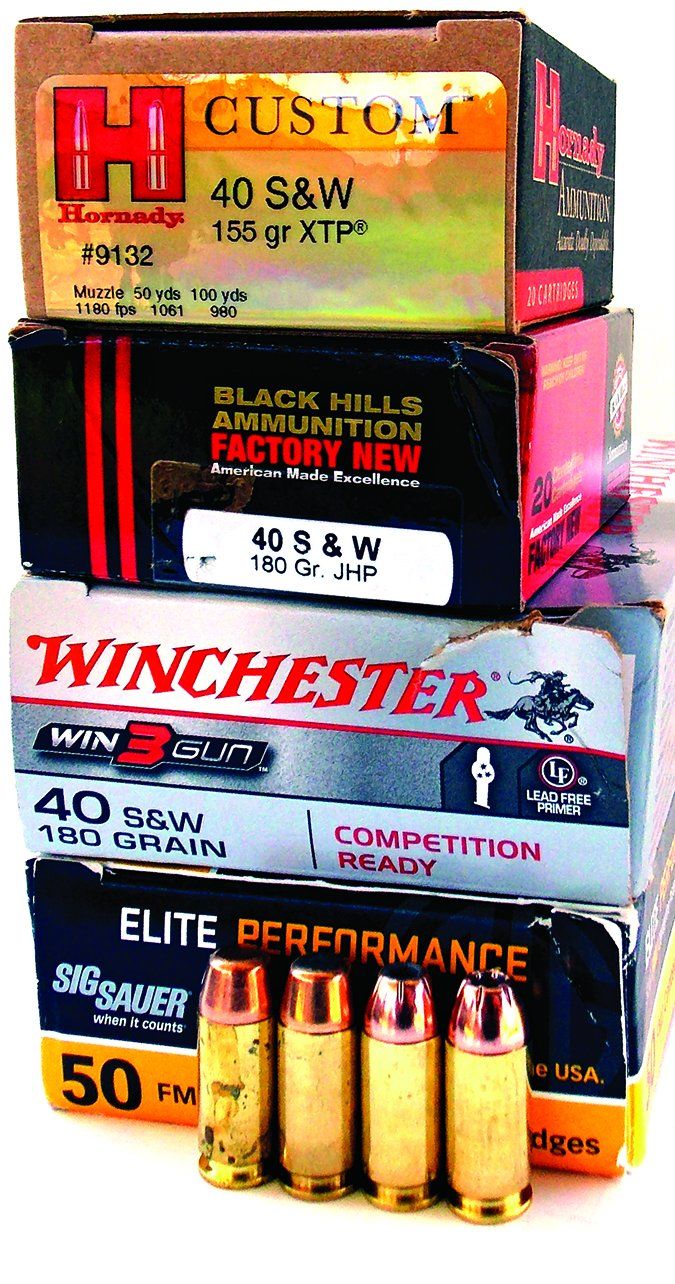
The 40 S&W ammunition used during the test gave good accuracy and never failed to fire. From top are the Hornady Custom 155-gr. XTP Jacketed Hollow Points #9132, the Black Hills 180-grain Jacketed Hollow Points, Winchester’s Win3Gun 180-grain Full Metal Jackets, and SIG Sauer’s Elite Performance 180-grain FMJ loads used during the combat firing stage.
The raters did not find a bad gun among the four, and we would buy any of them under the right circumstances. However, we preferred the others over the Ruger SR40.
Written and photographed by R.K. Campbell, using evaluations from Gun Tests team testers.

























